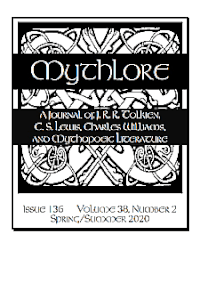 | |
| Discipline | Tolkien studies, fantasy, fanzine |
|---|---|
| Language | English |
| Publication details | |
| History | 1969-present |
| Publisher | Mythopoeic Society (United States) |
| Frequency | Biannually |
| Standard abbreviations | |
| ISO 4 | Mythlore |
| Indexing | |
| ISSN | 0146-9339 |
| OCLC no. | 751166319 |
| Links | |
Mythlore is a biannual (originally quarterly) peer-reviewed academic journal founded by Glen GoodKnight and published by the Mythopoeic Society.[1][2][3] Although it publishes articles that explore the genres of myth and fantasy in general, special attention is given to the three most prominent members of the Inklings: J. R. R. Tolkien, C. S. Lewis, and Charles Williams.[4][5] The current editor-in-chief is the Tolkien scholar Janet Brennan Croft.[6] The Tolkien Society describes Mythlore as a "refereed scholarly journal".[7]
YouTube Encyclopedic
-
1/5Views:1 677 8482 193 0511 809 700775 989361
-
Agartha, the Hidden Civilization of Inner Earth | Truth or Lore
-
Norse Mythology Stories: The Essential - From Creation to Ragnarok - See U in History
-
Miscellaneous Myths: Loki
-
Enochian, the Lost Language of Angels | Truth or Lore
-
Death Giant - African Myth - Lore and Stuff
Transcription
History
Mythlore appeared in January 1969 under the editorship of Glen H. GoodKnight, founder of the Mythopoeic Society. Early issues were fanzines, albeit with a "sercon" ("serious and constructive") bent; for a time it included alternate issues of Mythprint.[8] Mythlore became a peer-reviewed journal beginning with issue #85 (Winter 1999), under the editorship of Theodore Sherman. Since 2006, it has been edited by the Tolkien scholar Janet Brennan Croft.[9][6]
The full text of Mythlore from 2002 onward is available in Expanded Academic ASAP. Mythlore is also indexed in the Annual Bibliography of English Language and Literature, the Modern Language Association International Bibliography, and other sources. An agreement with JSTOR was announced in 2019. A detailed index (with abstracts) to issues 1-100 was published in January 2008 by The Mythopoeic Press. It has been superseded by an electronic index updated twice a year and available for free download from the journal's website. The journal became online open-access in 2017, and dropped its protection of articles less than one year old in 2019; back issues are available online through an arrangement with Southwestern Oklahoma State University Library.[10]
Tolkien Journal was an early "sercon" which was absorbed into Mythlore. It was started by New York Tolkien Society founder Richard Plotz in 1965. Dick Plotz stepped down after issue #8 and Ed Meškys took over the society and the journal. In issue #15, Meškys announced the permanent merger of the Tolkien Society of America with the Mythopoeic Society and of Tolkien Journal with Mythlore.[11] When GoodKnight became editor with Mythlore #12, the new subtitle "A Journal of J.R.R. Tolkien, C.S. Lewis, and Charles Williams Studies" replaced Tolkien Journal on the table of contents page.[12]
See also
References
- ^ "Series: Mythlore". Librarything. Retrieved 25 January 2021.
- ^ "Mythlore". Mythopoeic Society. Retrieved 25 January 2021.
A scholarly, peer-reviewed journal devoted to the study of mythopoeic literature
- ^ "Mythlore, Journal of The Mythopoeic Society". National Archives. Retrieved 25 January 2021.
- ^ Barella, Cecilia (2013) [2007]. "Tolkien Scholarship: Institutions". In Drout, Michael D. C. (ed.). The J. R. R. Tolkien Encyclopedia: Scholarship and Critical Assessment. Routledge. p. 658. ISBN 978-0-415-86511-1.
- ^ "Mythlore". Duotrope. Retrieved 25 January 2021.
- ^ a b Weinreich, Frank; Honegger, Thomas (2011). "Die aktuelle Tolkienforschung im Überblick: Personen – Organisationen – Verlage – Werke" [A Survey of Research on Tolkien: People – Organisations – Publishers – Works]. Zeitschrift für Fantastikforschung (in German) (2): 63–89. ISBN 9783643998880.
- ^ "Mallorn Editorial Board". The Tolkien Society. 12 September 2020. Archived from the original on 28 September 2020. Retrieved 28 September 2020.
She edits the refereed scholarly journal Mythlore
- ^ Mythlore. National Library of Australia. Retrieved 25 January 2021.
- ^ "Mythlore Publishing History". Archived from the original on 13 December 2006.
- ^ "Mythlore". SWOSU. Retrieved 28 September 2020.
- ^ "Mythlore A scholarly, peer-reviewed journal devoted to the study of mythopoeic literature: Tolkien Journal". Mythopoeic Society. Retrieved 4 April 2021.
- ^ "The Mythopoeic Society - Tolkien Journal". www.mythsoc.org.
External links
- Mythopoeic Society Mythlore pages
- Mythlore Online Archive at SWOSU (free download)
- Full history of Mythlore and Tolkien Journal, with checklist of published issues.

